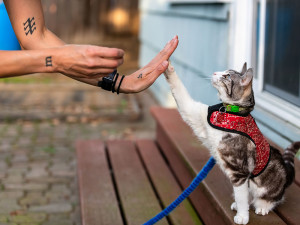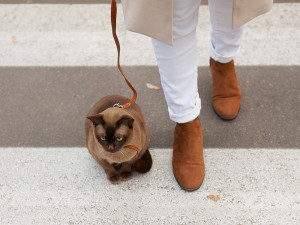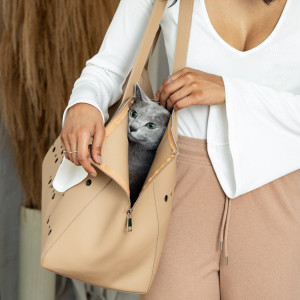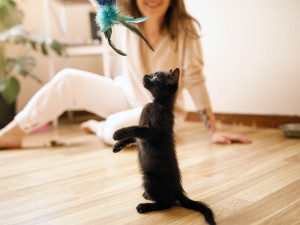How to Train Your Cat: Tips and Cues for Kittens
Seriously, it’s not as hard as you think.

Share Article
In This Article:
Kitten Training 101 Are Cats Easy to Train? Kitten Training Methods Basic Kitten Training Commands How to Discipline a Cat or Kitten FAQs
Let’s talk about training your kitten. Yep, you heard that right. Not only can you train cats, but you can start when they’re kittens. You can teach fun and helpful behaviors, like following a target or sitting on cue. Or you may come across a few behaviors you don’t love, like biting too hard during play or getting on the counter, that training can help manage. It’s also fantastic mental enrichment!
Kitten training 101
It’s important to start with realistic expectations. You can’t train away a cat’s instinctual behavior, like seeking food when hungry or scratching to spread their scent. However, you can encourage the behaviors you want to see more of through training. You can also work on behaviors that make cooperative care easier, such as trimming nails and giving meds. And you can have some fun with things like high-fives and ringing a bell.

Are kittens easy to train?
Cats who respond best to training are usually motivated by rewards, be it food, affection, verbal praise, tossing a toy, or something else they enjoy. It’s a barter system. If the reward is worth the effort, they’ll do it. If you’re asking too much of them, they don’t understand what they have to do to get the reward, or you’re trying to change a behavior without offering other ways for your cat to meet that same need, you won’t see results. Keep it simple.
How long does it take to train a kitten?
There’s no set timing for training. It depends on what you’re working on, how clear your training is, how motivated they are, how much time you dedicate, and a host of other elements. It’s best to take goal timelines out of the equation and work at your cat’s pace and with your schedule.
Kitten training methods
There are different ways to approach training. Some include upsetting tactics that can cause fear and stress for your cat. You will only ever hear me talk about positive training techniques. Never use fear, pain, or any negative tool for training. It will damage your relationship with your kitten and cause anxiety and other behavior issues.
Positive reinforcement
Positive reinforcement means that you reward your cat for the behavior you want to see more of. Whether in a formal training session where you’ve given a cue and they’ve followed it, or you happen to catch your kitten doing something you want to encourage, like using the scratching post instead of the couch, reward it! Rewarded behaviors are more likely to be repeated. This is the best way to train your kitten (or cat of any age).
Clicker training
I believe clicker training is one of the coolest and most useful things to do with your kitten. The idea is to teach them click equals reward. Then, you use a clicker (or another short, precise sound) to “mark” the behavior you want. In other words, it’s your way of saying, “Yes! What you were doing when you heard the click — that’s what I wanted, and that’s what you’re being rewarded for.”
Basic kitten training cues
There are countless ways to work with your kitten on training to make life easier and more for both of you. But don’t forget the fun. You can teach things that simply get your kitten using their brain and having a good time too.
Kitten obedience training basics
Obedience training is really just working with your kitten to follow specific cues generally meant to help them behave in a controlled manner. For example, teaching your kitten to look at you on cue gives you a way to turn their attention to you. It’s helpful in stressful situations or when you want your kitten to stop what they’re doing right away (like chewing on something dangerous). Target training can do the same. And it can evolve into things like following the target and jumping on and off of surfaces. Here’s how to teach these two helpful basics.
How to train your kitten to look at you
In this case, you want to “capture” what your kitten naturally does and turn it into a trained cue. If you’ve taught click equals reward, you’ll click and reward. If not, just say “yes” and reward. The clicker isn’t required.
Start by making a sound or motion that causes your kitten to look your way. As soon as they look at you, click or say “yes” and reward them. Do this a bunch of times. Then, add a verbal cue. Make the sound or motion and say, “Look at me.” When they look, you click or “yes” and reward. Do that a bunch of times.
Then, try only using the “Look at me” cue without the sound or motion. If they look, they’ve got it! Click or “yes” and reward. If it doesn’t work, just go back to the sound or motion plus the verbal cue for a while longer before trying again with only the verbal cue. They need more practice.
How to train your kitten to touch a target with their nose
Again, we’re capturing a natural behavior. You can use your finger or make a little target. Put something stinky on the end, like a liquid treat. Hold it in front of your kitten. They will naturally get up close to sniff the treat. As soon as the nose reaches the target, click or say “yes,” move the target away, and give a reward. Do this a bunch of times. Then, try it without the treat on the target. Just hold the target up. If they reach for it with their nose, they’ve got it! Click or “yes” and reward. If they don’t, go back to the treat on the end for a while. They just need more time to make the connection that their nose touching the target gets them a reward.
How to train a kitten to use a litter box?
This one is easy. If your litter boxes are set up well and meet your kitten’s instinctual needs, you shouldn’t have to do any training other than showing them where it is. You can, however, do some clicking and rewarding or basic positive reinforcement after they use the litter box to encourage that behavior.
Kitten behavioral training basics
If your kitten has a behavior you want to discourage, like scratching furniture, the first step is to figure out what need they’re trying to meet. There’s always a reason. Do they want their scent in that spot? Is the orientation and weight of the furniture better for scratching than their flimsy scratching post that wobbles? Do they use it for stretching after a nap nearby?
Then, provide an alternative option that works for you and meets those same needs. For example, if they’re scratching a chair, provide a scratcher in front of the chair, made of a similar material, that allows them to scratch in a similar way (horizontal vs. vertical, standing vs. crouching, etc.). At the same time, make the chair less attractive for scratching by covering it or blocking access. Reward your kitten for using the scratcher. Neutrally interrupt them if they scratch the chair. With a little time and patience, they’ll learn that one option gets them rewards and the other doesn’t. They should naturally prefer the rewarded option as long as it meets their needs. No punishment needed.
How to discipline a cat or kitten
I’d encourage you to reconsider the idea of “disciplining” your kitten. It implies punishment. And punishment will not work. Cats do what they do for a reason. There’s an instinctual driver behind their behavior. No amount of punishment is going to override thousands of years of instinct. Instead, try the tactics above — finding alternative ways to meet their needs and rewarding the behaviors you want to see more of. You’ll have much better results and a better relationship with your kitten.
FAQs (People also ask):
How can I clicker train my cat?
Clicker training cats is fun and easy. It’s about using the click to mark the behavior you want and teaching your cat they get a treat when they hear the click.
Should I use a spray bottle to train my cat?
No, you shouldn’t use a spray bottle to train your cat. Any method that causes stress or discomfort will do more damage than good. It will degrade your relationship and won’t teach your cat what they should do instead of the unwanted behavior.
Should I train my cat to use a harness?
Harness training is a great thing for cats to learn. It can provide safer outdoor time and also be helpful in emergencies where you may need to secure your cat without a carrier. Be sure to go slow, keep it super positive, and avoid pushing your cat past their comfort zone.
References:

LeeAnna Buis, CFTBS, FFCP
LeeAnna Buis has adored cats her entire life and thought she knew them inside out and sideways. But it wasn’t until she worked with a feline behavior consultant that she fully understood how incredible, complicated, and inspiring they really are. She made a career change, starting the certification process to become a behavior consultant right away. She discovered what unique, fascinating, complex creatures cats are and knew this was what she wanted to do with her life — help others on a similar journey to truly knowing, loving, and appreciating their cats.
LeeAnna earned her certification through Animal Behavior Institute, where she received the certified feline training and behavior specialist (CFTBS) designation.
Related articles
![cat playing fetch]()
How to Train a Cat
Move over, pups. This is a cat’s game, too.
Should You Train Your Cat to Use the Toilet?
This is not Meet the Parents.
![A gray cat in a tan cat carrier]()
How to Get a Cat in a Carrier
Here’s how you can train your stubborn cat to do one of their least-favorite things.
![A brunnette woman petting her black cat sitting on her desk while she prepares to give him a pill]()
How to Give a Cat a Pill
Everything you need to know about the difficult task of medicating a cat.
![Woman playing with a black kitten.]()
5 Kitten Behavioral Milestones You Should Know
Keep track of all their fun phases with these guidelines.
![Gray cat sniffing a glass on a shelf]()
How to Scent Train Your Cat
A veterinarian on how nosework and scent enrichment can strengthen your bond.










